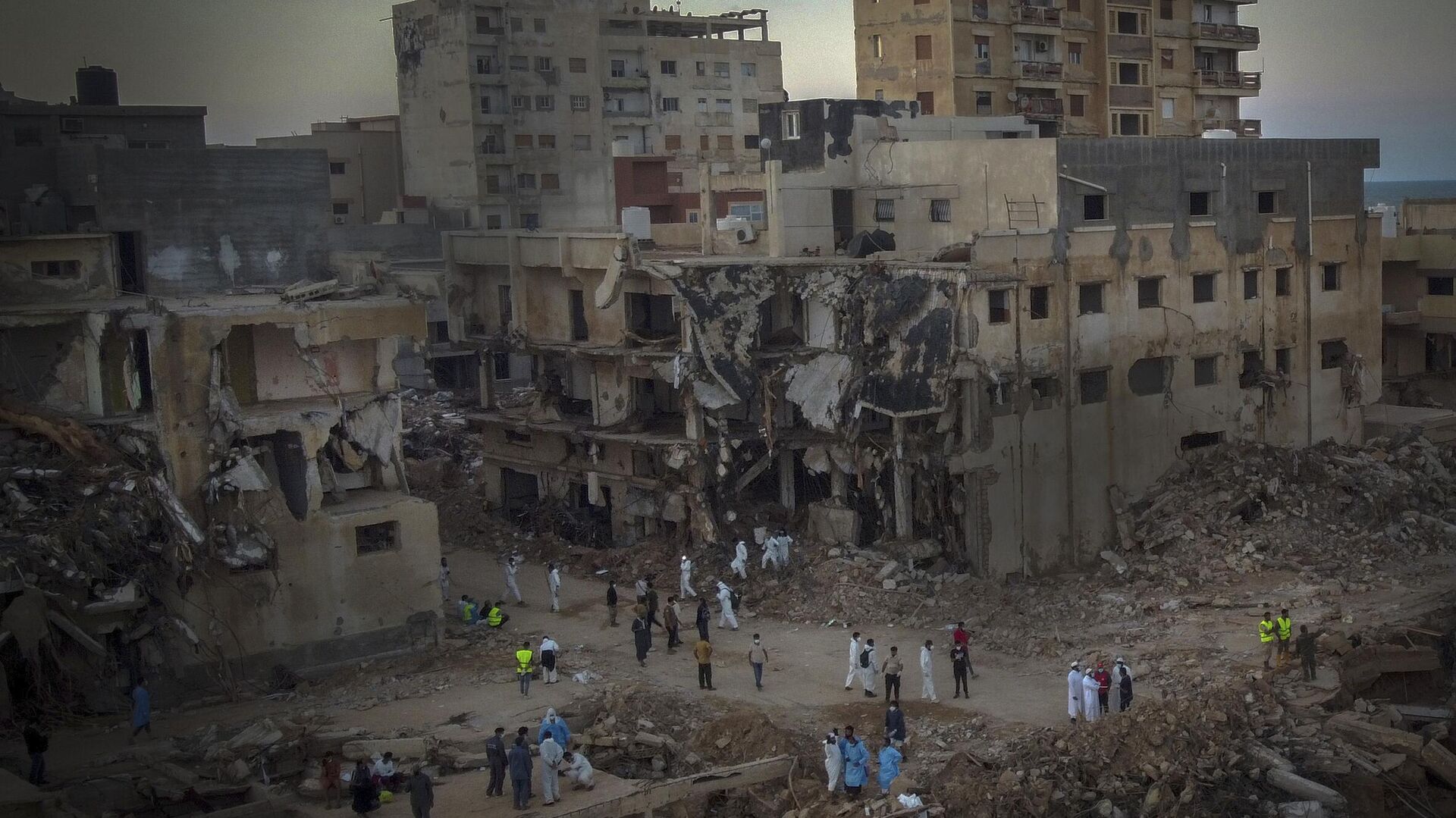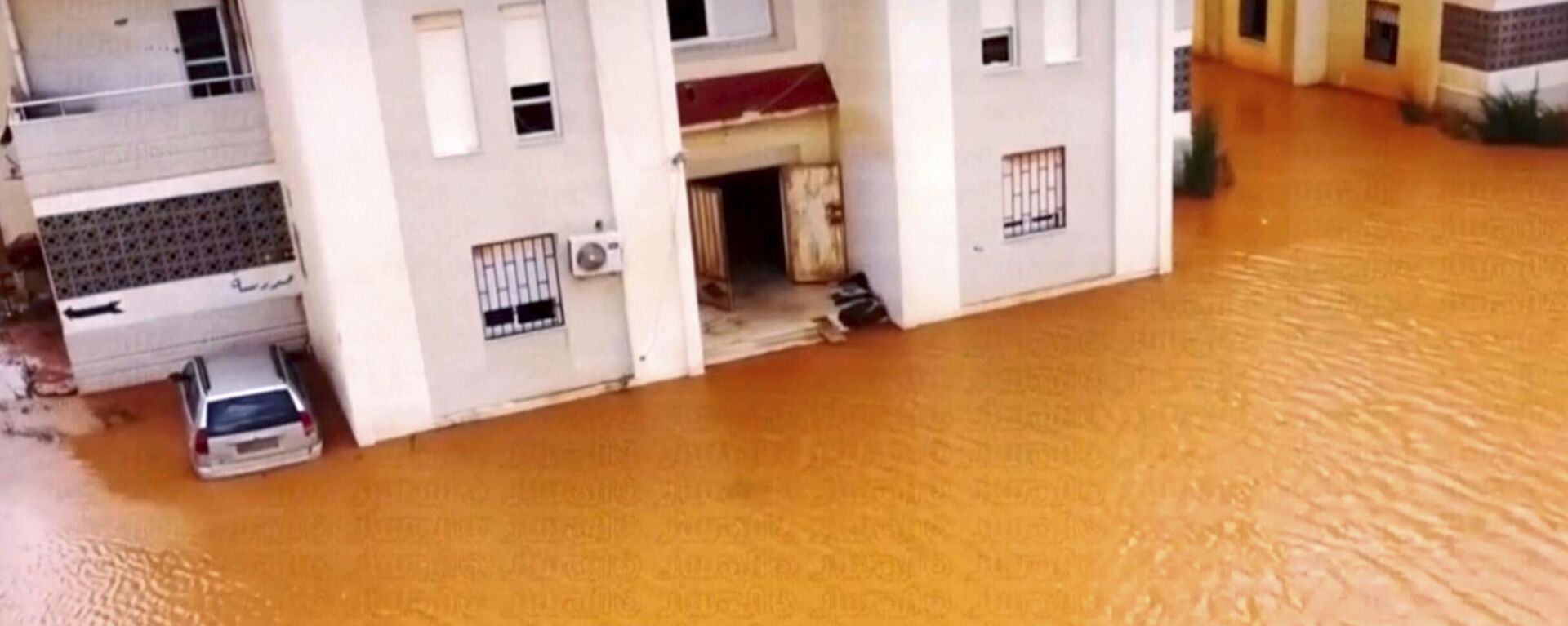https://en.sputniknews.africa/20230916/1062146003.html
Why Were Libya Floods So Severe?
Why Were Libya Floods So Severe?
Sputnik Africa
On September 10, a Mediterranean storm with hurricane characteristics caused torrential rains in the North African nation, the most affected areas were the... 16.09.2023, Sputnik Africa
2023-09-16T09:21+0200
2023-09-16T09:21+0200
2023-09-16T09:22+0200
libya
north africa
international
natural disaster
floods
united nations (un)
https://cdn1.img.sputniknews.africa/img/07e7/09/10/1062146181_0:74:2365:1404_1920x0_80_0_0_5d33e906f17b9668b5e9ec871fe637aa.jpg
Days after two dams in Libya's eastern city of Derna unleashed colossal amounts of water that swept away entire neighborhoods and killed thousands and left several thousand others missing, experts have pinpointed how a lethal combination of setbacks contributed to the severity of the catastrophe.While officials have not definitively attributed the storm to climate change, it has been acknowledged that the warming temperatures were among factors that contributed to the intensity of such extreme events.Additionally noted was the fact that Derna, a city historically susceptible to flooding, faced a critical issue with aging dams as they had been constructed by a Yugoslav company between 1973 and 1977, and had not undergone maintenance since 2002, according to Arabic media.A research paper from Libya's Sebha University had warned of the "catastrophic" flood potential and the need for periodic maintenance. It was further detailed how the area lacked sufficient vegetation to prevent soil erosion.Experts also highlighted the challenge of forecasting dam failures, which can be sudden and destructive. The risk posed by climate-induced extreme weather events to global infrastructure - from dams to buildings and water supplies, underscores the urgent need for preparedness in the face of the unexpected and intensifying climate-related challenges.Petteri Taalas, the head of the United Nations’ World Meteorological Organization, drew attention to issues regarding alert systems.Citing the Red Crescent Movement, local media reported the flooding death toll exceeded 11,000, with upwards of 10,000 people still missing. However, the latest official update on Wednesday afternoon put the death toll from the floods at over 7,000.The mayor of Derna, Abdulmenam Al-Ghaithi, said on Wednesday the death toll could reach as high as 20,000.Also of growing concern for authorities on the scene is the possibility of infections breaking out due to the late discoveries of decomposing bodies and a lack of burial spaces. Abdel-Rahim Mazek, the head of the main medical center in the city of Al Bayda, told Sputnik that "the spread of infections and epidemics" was a real factor in the area.
https://en.sputniknews.africa/20230912/1062056386.html
libya
north africa
Sputnik Africa
feedback@sputniknews.com
+74956456601
MIA „Rossiya Segodnya“
2023
News
en_EN
Sputnik Africa
feedback@sputniknews.com
+74956456601
MIA „Rossiya Segodnya“
Sputnik Africa
feedback@sputniknews.com
+74956456601
MIA „Rossiya Segodnya“
libya, north africa, international, natural disaster, floods, united nations (un)
libya, north africa, international, natural disaster, floods, united nations (un)
Why Were Libya Floods So Severe?
09:21 16.09.2023 (Updated: 09:22 16.09.2023) On September 10, a Mediterranean storm with hurricane characteristics caused torrential rains in the North African nation, the most affected areas were the eastern Lybian cities of Al-Bayda and Derna. Around 25% of Derna has been destroyed as a result of the natural disaster, according to the country's official.
Days after two dams in Libya's eastern city of Derna unleashed colossal amounts of water that swept away entire neighborhoods and killed thousands and left several thousand others missing, experts have pinpointed how a lethal combination of setbacks contributed to the severity of the
catastrophe.
While officials have not definitively attributed the storm to climate change, it has been acknowledged that the warming temperatures were among factors that contributed to the intensity of such extreme events.
Additionally noted was the fact that Derna, a city historically susceptible to flooding, faced a critical issue with aging dams as they had been constructed by a
Yugoslav company between 1973 and 1977, and had not undergone maintenance since 2002, according to Arabic media.
A research paper from Libya's
Sebha University had warned of the "catastrophic" flood potential and the need for periodic maintenance. It was further detailed how the area lacked sufficient vegetation to prevent soil erosion.
Experts also highlighted the challenge of forecasting dam failures, which can be sudden and destructive. The risk posed by climate-induced extreme weather events to global infrastructure - from dams to buildings and water supplies, underscores the urgent need for preparedness in the face of the unexpected and intensifying climate-related challenges.
Petteri Taalas, the head of the United Nations’ World Meteorological Organization, drew attention to issues regarding alert systems.
"If there would have been a normally operating meteorological service, they would have issued the warnings and also the emergency management of this would have been able to carry out evacuations of the people and we would have avoided most of the human casualties," Taalas told reporters at a Thursday conference, as quoted by media.
Citing the Red Crescent Movement, local media reported the flooding
death toll exceeded 11,000, with upwards of 10,000 people still missing. However, the latest official update on Wednesday afternoon put the death toll from the floods at over 7,000.
The mayor of Derna, Abdulmenam Al-Ghaithi, said on Wednesday the death toll could reach as high as 20,000.
Also of growing concern for authorities on the scene is the possibility of infections breaking out due to the late discoveries of decomposing bodies and a lack of burial spaces. Abdel-Rahim Mazek, the head of the main medical center in the city of Al Bayda, told Sputnik that "the spread of infections and epidemics" was a real factor in the area.


